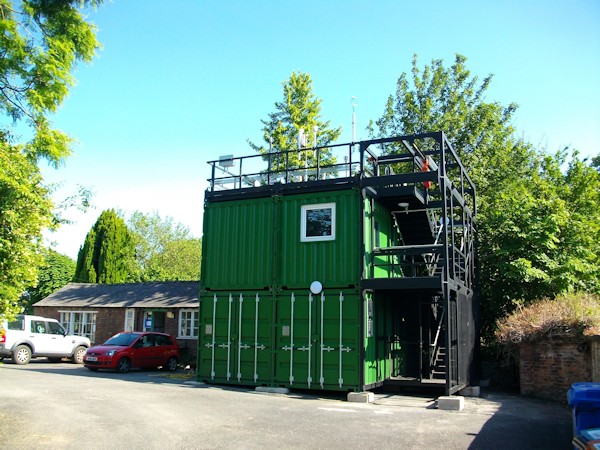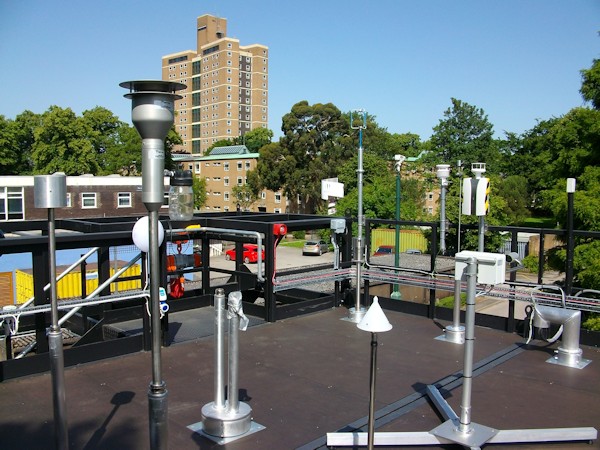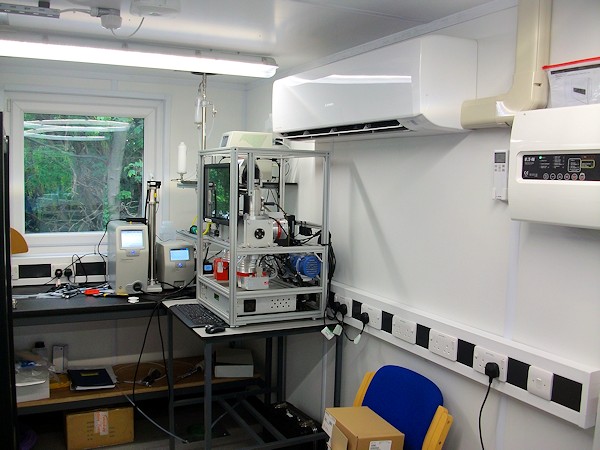Manchester Air Quality Super Site at the Firs Environmental Research Station, Fallowfield Campus

External view of Manchester Air Quality Super Site
Introduction
"Poor air quality is the largest environmental risk to Public Health in the UK" (DEFRA, 2017) and is consequently a focus of a range of regional and national policy interventions. However, since our transport systems, the way we heat our homes, our energy supply, our use of solvents and our agricultural systems are all changing, we know that profound changes in emissions and trends in air pollutants are likely in the coming years and indeed are already taking place. We need to understand our changing atmospheric composition, to ensure air quality policy has maximum benefit for the protection of human and environmental health.
One of the largest research stations in the UK dedicated to air quality research, the Manchester Air Quality Supersite (MAQS) is packed with state of the art technology that allows scientists to probe the atmosphere in greater detail than at standard network sites. Using real-time data acquired from co-located gas, aerosol with meteorological instruments, scientists can unpick the myriad of factors that contribute to poor air quality, gaining greater understanding of the pollution sources and transformational processes that take place in the urban environment.
Located on the University of Manchester's Fallowfield Campus a short distance to the south of Manchester City Centre the supersite is in an ideal location to characterise air quality in an urban background environment, exactly the type of environment where a large fraction of the population spend a significant portion of their lives.
Measurements Being Made
Measurements at the supersite are split into 3 main groups: gases, aerosols (tiny particles suspended in the air) and meteorology.
Gas measurements at the site include gases such as ozone, oxides of nitrogen and carbon monoxide which are routinely mesaured at network monitoring sites, additionally the significant greenhouse gases carbon dioxide and methane, along with ammonia are also measured and reported in real time. The site is also equipped with a gas chromatograpy instrument operated by The University of York which is measuring hydrocarbons.
Aerosol measurements include physical properties - mass (total suspended particulates, PM10, PM2.5, PM1), total number and size distribution, and detailed chemical composition including black and brown carbon, non refractory (eg organics, nitrate, sulphate and ammonium) material, and elemental analysis. Additionally the site is equipped with an automatic filter sampler for collection of samples for later analysis by a variety of techniques.
As the weather has a major impact on the dispersion and removal of pollutants and hence air quality, the site is also equipped with an advanced set of meteorological instruments measuring pressure, temperature, humidty, wind, rain, solar radiation, cloud cover and boundary layer and cloud height.
The table below lists the main long term measurements and the instruments being used.
Manchester Air Quality Supersite Instrument Table |
|||
Parameter Measured |
Instrument |
Range and Accuracy |
Time Resolution |
The Gas Lab (Live Gas Plots) |
|||
Ozone (O3) |
Thermo 49i |
0.5ppb - 200ppm, 1ppb | 20s |
Nitric Oxide (NO) |
Thermo 42i-y |
50ppt - 1000ppb, 0.4ppb | 20s |
Nitrogen Dioxide (NO2) |
Teledyne API T500U (CAPS) |
40ppt - 1000ppb, 0.5% | 10s |
NOy |
Thermo 42i-y |
50ppt - 1000ppb, 0.4ppb | 20s |
Ammonia (NH3) |
LGR Economical Ammonia Analyser |
0.5-10000ppb, 1.5ppb | 1s |
Carbon Monoxide (CO) |
Thermo 48i |
0.04-10,000ppm, 0.1ppm | 20s |
Carbon Dioxide (CO2) |
LGR Multi-gas Carbon Emissions Analyser |
0.1-3000ppm, 0.3ppm | 1s |
Methane (CH4) |
LGR Multi-gas Carbon Emissions Analyser |
0.3ppb - 100ppm, 2ppb | 1s |
Hydrocarbons |
Gas Chromatograph |
||
The Aerosol Lab (Live Aerosol Plots) |
|||
Particulate Matter (PM1, PM2.5, PM10) |
Palas FIDAS200 |
0-10,000ug/m3, <10% | 1min |
Black/Brown Carbon |
McGee Aethalometer AE33 |
0.01-100ug/m3 | 1min |
Non-refractory composition |
Aerodyne ACSM |
30min | |
Elemental Composition |
Cooper XACT 625i |
1hour | |
Particle Size Distribution |
TSI 3082 SMPS and Palas FIDAS200 |
15nm - 10um | 5min |
Particle Number |
TSI 3750 CPC |
0-100,000 particles/cm3 | 1s |
The Met Lab (Live Meteorology Plots) |
|||
Wind Speed and Direction |
Gill Windmaster Sonic Anemometer |
0-50m/s, 0.01m/s 0-359deg, 0.1deg |
20Hz |
Temperature, Humidity and Pressure |
|
-40 - +60C 0-100%RH 500-1100hPa |
1min |
Precipitation (rate and type) |
Theis Laser Precipitation Monitor |
0.005 - 250mm/hr Identification of precip type |
1min |
Boundary Layer and Cloud Base Height |
Lufft 8K Ceilometer |
8km, 15m | 15s |
Solar radiation |
Ocean Optics Spectral Radiometer with 2pi Actinic Flux head. |
5s | |
Data Usage and Availability
Data from the super site is being used to support a number of active research projects at the University of Manchester and in the wider academic community, and is also being used to provide data to local government and national policy makers. Data plots are publically available on this website.
The Multi-Disciplinary Research Space
With over 13m2 of collaborative research space with dedicate inlets and expert support in ambient atmospheric measurement, we can support your field measurements for multi-disciplinary research. In addition, High Volume Filter sampling service is available using our Digitel HV sampler.
Links to Further Information and Data
Real time data display
Current data table
Plot archive
For further information or to request observatory datasets please contact Dr. Nicholas Marsden .

Rooftop view of Manchester Air Quality Super Site

Instruments in the aerosol lab at the Manchester Air Quality Super Site